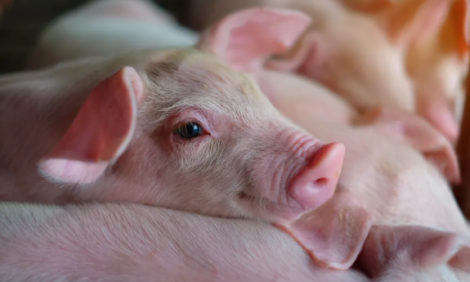



Proceed Carefully with Feed Alternatives
By Dr Chad Hastad, Swine Nutrition Services Inc. who explains that care is needed when considering unfamiliar feed ingredients for pig diets.With the high cost of feed, we get a lot more questions about 'cheapening up' diets. Before we look at alternative ingredient options, there are a number of things you should be doing right now to counter higher feed costs:
- Lower particle size to improve feed efficiency
- Keep feeders adjusted correctly
- Look at market weights and adjust down if it makes sense
- Consider eliminating all fat from diets
- Look at increasing inclusion rates of dried distillers grains (DDGs)
- Evaluate how Paylean is being used
- Work with your nutritionist/vet/suppliers/banker on farm to find ways to save dollars on your operation
- Make decisions based on facts, not emotions
- Look at feed budgets – are they correct and are they being followed?
- Look at possible equipment changes to improve efficiency (feeders, waterers, etc)
If you are following these fundamentals, you can be more pro-active in looking at alternative ingredients. These could be any other energy or protein source. Our clients have fed a wide range of products, including pet food, sticky granola, Jolly Ranchers, brown sugar, corn flour and soup mix by-product.
When considering any by-product, these are the questions you should be asking:
- What is the nutrient composition? Table 1 shows the nutrient values of various grains and by-products compared to corn. Table 2 and Table 3 show maximum usage rates for common protein and energy sources.
| Table 1: Relative Ingredient Values Compared to Corn | |
| Corn | 100 |
| Bakery waste/cereal fines | 105-110 |
| Barley | 90-95 |
| Dried distillers grains | 75-130 |
| High-lysine corn | 110-115 |
| High-oil corn | 110-115 |
| NutriDense corn | 110-115 |
| Milo/sorghum | 96 |
| Oats | 70-80 |
| Rye | 80-85 |
| Soy Hulls | 60-65 |
| Triticale | 95-105 |
| Wheat | 105-107 |
| Wheat middlings | 90-95 |
| Table 2: Typical Maximum Usage Rates (%) for Common Energy Sources | |||||
| Ingredient | Starter | G/F | Gestation | Lactation | Limitation |
|---|---|---|---|---|---|
| Bakery waste, dehy | 25 | * | * | * | High salt |
| Barley | 25 | * | * | 25 | High fiber |
| Corn | * | * | * | * | None |
| DDGS | 20 | 20 | 30 | 5 | Palatability |
| Corn gluten feed | 5 | 10 | * | 5 | High fiber |
| Corn, hominy feed | 0 | 60 | 60 | 60 | AA balance |
| Molasses | 0 | 5 | 10 | 5 | Low energy |
| Rye | 0 | 25 | 25 | 10 | Variability |
| Sorghum (milo) | * | * | * | * | None |
| Soy hulls | 5 | 10 | 20 | 0 | Low energy |
| Triticale | 10 | * | * | 50 | Variability |
| Wheat bran | 0 | 10 | 30 | 10 | Low energy |
| Wheat, hard | * | * | * | * | None |
| Wheat middlings | 5 | 25 | * | 5 | Low energy |
| Wheat shorts | 10 | 40 | 40 | 40 | Variability |
| Tokach 2007 | |||||
| Table 3: Typical Maximum Usage Rates (%) for Common Protein Sources | |||||
| Ingredient | Starter | G/F | Gestation | Lactation | Limitation |
|---|---|---|---|---|---|
| Alfalfa meal, dehy | 0 | 10 | 25 | 0 | High Fiber |
| Canola meal | 0 | 15 | 15 | 15 | Anti-nutrition |
| Corn gluten meal | 10 | 30 | * | 10 | AA balance |
| Cottonseed meal | 0 | 10 | 15 | 0 | Low lysine |
| Meat and bone meal | 5 | 5 | 10 | 5 | High minerals |
| Meat meal | 0 | 5 | 10 | 5 | High minerals |
| SBM, extr/expelled | * | * | * | * | None |
| Soybean, full-fat | * | * | * | * | Overheating |
| Sunflower meal | 0 | 20 | * | 0 | Low energy |
| Yeast, brewers dried | 5 | 10 | 10 | 10 | Variability |
| Tokach 2007 | |||||
- How variable is the quality of the product as delivered and how will I deal with the variation?
- In what form does the by-product come?
- How does the ingredient impact diet flowability, bulk density and feed milling? For example, higher inclusion rates of DDGs will affect transportation. At 40 per cent inclusion, a 24-ton truck may only hold 18 to 22 tons of feed. This will increase transportation cost per ton of complete feed.
- Is bin space available?
- How will the ingredient impact growth performance and carcass parameters (leanness and fat quality)?
- Will the product be available consistently at an economical price?
- Do I save enough money for the added risk?
If you can answer these questions and you believe the risks are worth it, use alternatives. There may be many of opportunities available to you locally if you look for them. Monitor performance carefully and make adjustments quickly if you have to.
October 2008







